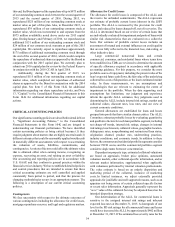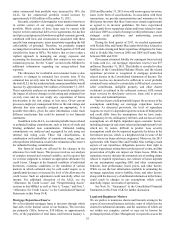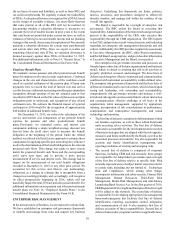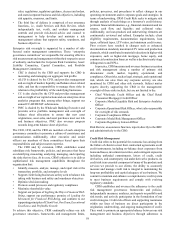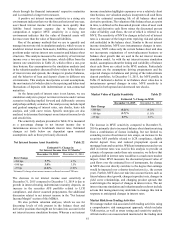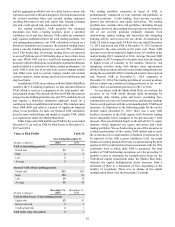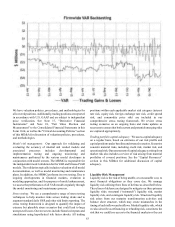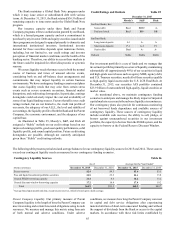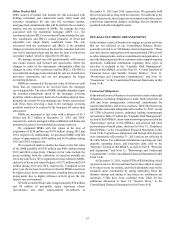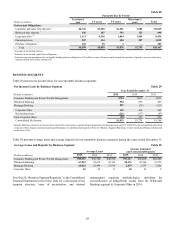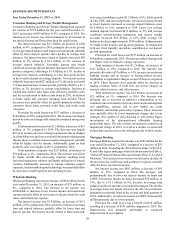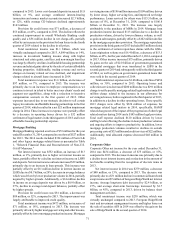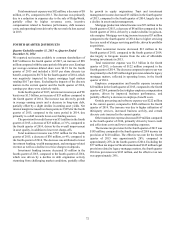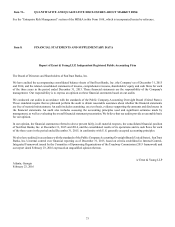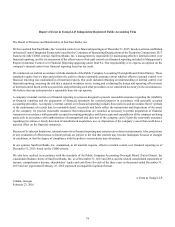SunTrust 2015 Annual Report Download - page 92
Download and view the complete annual report
Please find page 92 of the 2015 SunTrust annual report below. You can navigate through the pages in the report by either clicking on the pages listed below, or by using the keyword search tool below to find specific information within the annual report.64
of such access may rise to undesirable levels. Contingent
liquidity risk arises from rare and severely adverse liquidity
events; these events may be idiosyncratic or systemic, or a
combination thereof.
We mitigate these risks utilizing a variety of tested liquidity
management techniques in keeping with regulatory guidance and
industry best practices. For example, we mitigate structural
liquidity risk by structuring our balance sheet prudently so that
we fund less liquid assets, such as loans, with stable funding
sources, such as consumer and commercial deposits, long-term
debt, and capital. We mitigate market liquidity risk by
maintaining diverse borrowing resources to fund projected cash
needs and structuring our liabilities to avoid maturity
concentrations. We test contingent liquidity risk from a range of
potential adverse circumstances in our contingency funding
scenarios. These scenarios inform the amount of contingency
liquidity sources we maintain as a liquidity buffer to ensure we
can meet our obligations in a timely manner under adverse
contingent liquidity events.
Governance. We maintain a comprehensive liquidity risk
governance structure in keeping with regulatory guidance and
industry best practices. Our Board, through the BRC, oversees
liquidity risk management and establishes our liquidity risk
appetite via a set of cascading risk limits. The BRC reviews and
approves risk policies to establish these limits and regularly
reviews reports prepared by senior management to monitor
compliance with these policies. The Board charges the CEO with
determining corporate strategies in accordance with its risk
appetite and the CEO is a member of our ALCO, which is the
executive level committee with oversight of liquidity risk
management. The ALCO regularly monitors our liquidity and
compliance with liquidity risk limits, and also reviews and
approves liquidity management strategies and tactics.
Management and Reporting Framework. We base our
governance structure on and mitigate liquidity risk using three
lines of defense. Our Corporate Treasury department constitutes
the first line of defense, managing consolidated liquidity risks
we encounter in the course of our business. Under the oversight
of the ALCO, Corporate Treasury thereby assumes responsibility
for identifying, measuring, monitoring, reporting, and managing
our liquidity risks. In so doing, Corporate Treasury develops and
implements short- and long-term liquidity management
strategies, funding plans, and liquidity stress tests, and also
monitors early warning indicators. Corporate Treasury primarily
monitors and manages liquidity risk at the Parent Company and
Bank levels as the non-bank subsidiaries are relatively small and
these subsidiaries ultimately rely upon the Parent Company as
a source of liquidity in adverse environments. However,
Corporate Treasury also monitors liquidity developments of, and
maintains a regular dialogue with, our other legal entities.
Our MRM group constitutes our second line of defense in
liquidity risk management. MRM conducts independent
oversight and governance of liquidity risk management
activities. For example, MRM works with Corporate Treasury
to ensure our liquidity risk management practices conform to
applicable laws and regulations and evaluates key assumptions
incorporated in our contingency funding scenarios.
Our internal audit function provides a third line of defense
in liquidity risk management. The role of internal audit is to
provide assurance through an independent assessment of the
adequacy of internal controls in the first two lines of defense.
These controls consist of procedural documentation, approval
processes, reconciliations, and other mechanisms employed by
the first two lines of defense in ensuring that liquidity risk is
consistent with applicable policies, procedures, laws, and
regulations.
In September 2014, the Federal Reserve published final
rules with respect to LCR requirements under Regulation WW.
The LCR requires banking organizations to hold unencumbered
high-quality liquid assets sufficient to withstand projected cash
outflows under a prescribed liquidity stress scenario. Regulation
WW will be phased in as specified with the regulatory
requirements and requires that we maintain an LCR above 90%
beginning January 1, 2016 and 100% beginning January 1, 2017.
We expect to meet or exceed LCR requirements within the
regulatory timelines. At December 31, 2015, our LCR was above
the January 1, 2016 requirement of 90%.
Uses of Funds. Our primary uses of funds include the extension
of loans and credit, the purchase of investment securities,
working capital, and debt and capital service. The Bank and the
Parent Company borrow in the money markets using instruments
such as Fed funds, Eurodollars, and CP. At December 31, 2015,
the Parent Company had no CP outstanding and the Bank
retained a material cash position in its Federal Reserve account.
The Parent Company also retains a material cash position, in
accordance with our policies and risk limits, discussed in greater
detail below.
Sources of Funds. Our primary source of funds is a large, stable
deposit base. Core deposits, predominantly made up of consumer
and commercial deposits originated primarily from our retail
branch network and Wholesale Banking client base, are our
largest and most cost-effective source of funding. Core deposits
increased to $148.9 billion at December 31, 2015, from $139.2
billion at December 31, 2014.
We also maintain access to diversified sources for both
secured and unsecured wholesale funding. These uncommitted
sources include Fed funds purchased from other banks, securities
sold under agreements to repurchase, negotiable CDs, offshore
deposits, FHLB advances, Global Bank Notes, and CP.
Aggregate wholesale funding decreased to $13.8 billion at
December 31, 2015 from $19.4 billion at December 31, 2014.
Net short-term unsecured borrowings, which includes wholesale
domestic and foreign deposits as well as Fed funds purchased,
decreased to $3.8 billion at December 31, 2015, from $4.2 billion
at December 31, 2014. The decrease in both wholesale funding
and net short-term unsecured borrowings compared to
December 31, 2014 was due to the growth in core deposits.
As mentioned above, the Bank and Parent Company
maintain programs to access the debt capital markets. The Parent
Company maintains a SEC shelf registration from which it may
issue senior or subordinated notes and various capital securities
such as common or preferred stock. Our Board has authorized
the issuance of up to $5.0 billion of such securities, of which
$5.0 billion of issuance capacity remained available at
December 31, 2015.


